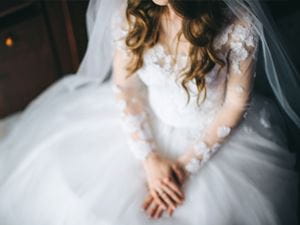
Shutterstock.com
Just about everyone in the Western world envisions a similar image when they picture a wedding. Family and friends are arrayed in neat rows at some scenic location. Bridesmaids in carefully coordinated, if not matching, dresses stand across from the groom in his black tuxedo. The groomsmen stand behind him. They are also in black suits. The bride is walked down the aisle by her father. She is wearing beautiful diamond jewelry with her hair carefully styled. Her dress is floor length and elaborate. It is, of course, pure white.
The white dress has become as much a symbol of a Christian wedding as wedding bands and diamond engagement rings, if not more. Does that mean the pure white is a requirement of a Christian bride? Other colored or white-with-color dresses may be less traditional, but are they less Christian?White wedding dresses are often associated with innocence and purity, qualities that some Christians find extremely important in brides. The connection between a white dress and a virgin bride, however, is rather recent.
During the Medieval and Renaissance eras, brides never wore white. White was associated with mourning, and when Mary, Queen of Scots, wore white to her wedding in 1559, she was accused of cursing her husband. White was her favorite color, but the supposed curse she brought to her husband was believed to have caused his death a few short years later.
In that period, brides would wear richly colored fabrics made of silk, muslin, velvet and fur instead of white. The gowns were layered with jewels and any other obvious sign of wealth that was available. As marriages were most often for political or financial reasons, a bride’s gown was an easy and common way to show off her family’s wealth. In 1468, Margaret of York’s wedding dress was supposedly so heavy that she had to be carried into the church.
In addition to rich fabrics emphasizing a family’s affluence, white was simply not practical in early ages. White was all but impossible to keep clean, and the garment would be filthy from drinking, dancing and eating by the end of the wedding. As wedding dresses were worn repeatedly as part of a wife’s normal wardrobe, the use of an easily ruined dress was wasteful and foolish.
White wedding dresses would not become popular until the middle of the 19th century. Until then, red or blue were the dominant colors used at weddings. Blue was associated with purity and virginity, hence why the Virgin Mary is so often depicted wearing blue clothing. Red, meanwhile, was associated with fertility, and for centuries, the most important aspect of any marriage was the number of children it produced.
Considering how many centuries colored gowns had been used, white wedding dresses became the norm almost overnight following the wedding of Queen Victoria in 1840. Victoria deliberately chose to wear white because it would create a more simple dress, a far cry from how brides today subtly compete to have the most elaborate dress. When Victoria married Albert, however, she wanted to say her vows not as a monarch but as a woman in love. As such, she spurred the royal finery and opted for something simple. She chose white satin because it was both simple and would display lace well. Victoria hoped that by wearing handmade Honiton lace from Beer she would help boost the declining lace industry.
Rather than focusing on the lace, however, most people zeroed in on the color of Victoria’s dress. Many of those watching the royal wedding were at first disappointed that Victoria was not wearing the crimson velvet robe of state. The affair seemed underwhelming at the time. A few short years later, though, white was the dominant color of wedding dresses for those who could afford them. A poem in “The Farmer’s Almanac” made it clear that white was the only color for brides. “Married in White, you have chosen right. Married in Grey, you will go far away. Married in Black, you will wish yourself back. Married in Red, you will wish yourself dead. Married in Green, ashamed to be seen. Married in Blue, you will always be true. Married in Pearl, you will live in a whirl. Married in Yellow, ashamed of your fellow. Married in Brown, you will live in the town. Married in Pink, your spirit will sink.” Similarly, “Godey’s Lady Book” declared that “custom has decided, from the earliest ages, that white is the most fitting hue, whatever may be the material. It is an emblem of the purity and innocence of girlhood, and the unsullied heart she now yields to the chosen one.” History shows this is simply not correct. The trend, however, had been set. Brides wore white.
White was later associated with both the white gowns Catholic girls wear on their First Communion and Christening gowns. This only further cemented the idea that white gowns meant innocent brides. This relatively recent tradition, however, is largely confined to Western Christians. Many Eastern weddings use red wedding dresses as red is the color associated with good luck. White, meanwhile, maintains its status as a mourning color. As such, an Indian Christian bride is rather unlikely to walk down the aisle wearing white. Instead, she will probably wear a red sari.
Even though white remains the overwhelming norm for wedding dresses in the West, increasing numbers of brides are adding color to their dresses or eschewing white altogether. These weddings, however, are no less Christian simply because the bride walks down the aisle wearing purple. It is the vows and the people who determine if a wedding is a Christian wedding, not the color fabric the bride has chosen to wear.

